I remember my mother cooking for us kids back in the 1960s. She had this thing (as all our moms did) with BIG hair. She would wear these curlers in her hair all day, and they were enormous round things too. And when she would cook, she would have this long ashy cigarette in her mouth, or held in her long fingernailed hand while she would cook on our olive green stove.
We had a yellow (Ma Bell) telephone on the wall. It had a rotary dial, and a long cord so that you could talk in the other room if you wanted some privacy.
We had numerous ashtrays in the house. One had a beanbag on the bottom, so that it can be used on the sofa.
My mother would light her cigarette on the electric stove, by using the burner. And when she was finished she would toss it in the garbage disposal unit in the sink.
Our kitchen had olive appliances; olive refrigerator, stove, and this enormous Sears microwave that sat up on the red countertop of our yellow metal cabinets. We had the ceramic his and her salt and pepper shakers that looked like a boy and girl kissing, a macramé plant holder near the window, an old picture of a sad clown on the wall, and (near the TV room) two paintings of big-eyed beatnik boy and a girl. The boy had a guitar, and the girl had a tambourine in her hands.
I guess you never see that these days, a mother cooking with a cigarette in one hand and frying bacon in the other. But I’ll never forget the scene.
China’s CPC has an instruction manual to prevent USA organized color revolutions:
China has put it’s foot down and said NO NO NO MORE. And it will no longer allow, permit or tolerate efforts at “color revolutions” instead of war in it, or it’s aligned nations.
Here’s the translated article…
Persevere in Placing Political Security in the Predominant Position
坚持把政治安全放在首要位置
Introduction
For China’s first generation of communist leaders, revolution meant baptism by smoke and gunpowder. Their path to political power snaked through battlefields and prison cells littered with the bodies of dead comrades. Only narrowly did their party escape total annihilation.
Decades spent shadowed by death instilled a keen awareness of peril in the psyche of the cadres who survived. Neither political power nor battlefield victory ever soothed away this sense of threat.
However, the Party’s successful seizure of power did change which danger its leaders perceived as most threatening.
Mao Zedong would label this peril the threat of “peaceful evolution.”1 Though warnings of peaceful evolution are still issued, contemporary party documents, such as the translated material presented below, more often frame the danger in terms of “political security” [政治安全].2
Both phrases articulate a fear that hostile foreign powers seek to leverage dissent in China to subvert or overthrow communist rule of China.
Translated below is an authoritative discussion of this threat as party leaders perceive it.
It was originally published as the sixth chapter of The Total National Security Paradigm: A Study Outline 《总体国家安全观学习纲要》a 150 page textbook created jointly by the Office of the Central National Security Commission and the Central Propaganda Department of the Communist Party of China.
The Study Outline was released on April 14th, 2022 and subsequently distributed to party committees at all administrative levels as an “an important and authoritative auxiliary text for the broad mass of cadres” to include in their group study sessions.3
Published shortly after the creation of the PRC’s National Security Strategy [国家安全战略] and concurrently with a bureaucratic expansion of the state security complex to the local administrative level,4 the book is designed to provide an accessible and unclassified overview of the security doctrine millions of cadres are now expected to implement.
At the center of these ideas is the Total National Security Paradigm, a set of concepts that party sources describe as Xi Jinping’s signature contribution to Chinese security theory.
The textbook’s publication was carefully timed to coincide with the eighth anniversary of the meeting where Xi first introduced this paradigm.
In that meeting Xi instructed party cadres to “pay attention to both traditional and non-traditional security, and build a national security system that integrates such elements as political, military, economic, cultural, social, science and technology, information, ecological, resource, and nuclear security.”5
Threats to “traditional security” include those that can be handled through normal military means; “non-traditional security threats” comprise the rest of Xi’s long list—a list that has only gotten longer in the years since, as terms like “food security” and “biosecurity” have been added to the catalog.
Yet not all non-traditional fields of security are created equal. In that same 2014 speech Xi informed the Party that “political security is our fundamental task.”6
This judgment is echoed in the structure of the Study Outline, where it is the only field of security—including the traditional military sort—to be given its own chapter length discussion.7
The Study Outline makes clear why political security deserves such high priority. “Political security,” it instructs, “means safeguarding the ruling position and leadership status of the Chinese Communist Party and safeguarding the institution of Socialism with Chinese Characteristics.”
The manual describes Socialism with Chinese Characteristics as “a rigorous, comprehensive, and scientific system of institutions” whose institutional integrity guarantees China’s return to national greatness. “If institutions are stable, so is the state.”
On the other hand, if “political security cannot be guaranteed, the state will inevitably disintegrate like a sheet of loose sand.”
The Study Outline warns that this “is a real and present danger.” China is engaged in an “institutional competition,” the “most fundamental type of competition between states.”
Arrayed against the Chinese system are powerful “hostile forces” who “persistently seek to ferment a ‘color revolution’ within our state, vainly attempting to subvert the leadership of the Chinese Communist Party and the socialist institutions of our state.”
Party members should not be fooled by periods of tranquility or moments of détente: these hostile forces “have never abandoned their subversive intent to Westernize and divide our state.
They do not rest, not even for a moment.” Nor is compromise or concession a workable solution. “In the realm of ideological conflict,” the Study Outline instructs, “we have no way to compromise and no place to retreat to. We must obtain total victory.”
The Study Outline views ideology as the primary battlefield of institutional competition: Those who “sow chaos and subvert sovereign power often begin by piercing a hole in the realm of ideology and sowing chaos in the thoughts of the people.” The ideological realm must be defended, for “once the defensive line in thought has been breached it is difficult for other defensive lines to hold.”
The Study Outline directs cadres to pay special attention to three domains where the defensive lines must hold: on the internet, in the schools, and among China’s religious and ethnic minorities.
In all three domains the Study Outline describes events that Western observers tend to depict as spontaneous reactions to government policy as incidents carefully orchestrated by party enemies.
When viral outrage leads to mass protests, cadres can be assured that such events are “intentionally chosen, follow a plan, and are organized and contrived ahead of time” by hostile forces.
If university students have learned to “bite the hand that feeds them and kick the wok that fills them” it is because the hearts of “our youth are the territory that hostile forces spend the most effort fighting for.” If the “ethnic consciousness” of minority groups is not “subordinate to and serving the common Chinese national identity” this is because “hostile forces at home and abroad use ethnic problems to carry out separatism, infiltration, and sabotage activities.”
Though “disintegration of sovereign power” may “begin in the realm of thought,” the enemies and weapons faced in that realm are just as dangerous as those faced in the more tangible world of blood and bullets.
The Study Outline’s assertion that “the disintegration of sovereign power often begins in the realm of thought” presents a sharp contrast with Mao’s famous argument that “sovereign power grows out of the barrel of a gun.”
Underlining Xi Jinping’s Total Security Paradigm is the recognition that not all problems can be solved by gun barrel. But that recognition is not new. Mao himself reached the same realization when he credited the de-Stalinization of Europe to ideological subterfuge, fearing that a similar combination of internal sabotage and external pressure might derail China’s revolution. Deng Xiaoping reached a similar conclusion following the fall of the Berlin Wall and the protests at Tiananmen Square. The United States and its allies “engage in peaceful evolution,” Deng declared. Their strategy is to “wage a world war without smoke or gunpowder.”8
The dangers Mao and Deng feared in their twilight years dominated Xi formative ones. Xi Jinping does not believe the threat has abated: the close attention he pays to the Party’s political security has been a defining thread of his rule. Manuals like this Study Outline signal his determination to overcome the threat of peaceful evolution.
They are a survival guide to wars waged without smoke or gunpowder.
—THE EDITORS
1. The label was inspired by U.S. Secretary of State John Foster Dulles’s 1958 judgment that “internal pressures are bound to alter the character of the communist regimes,” thus American foreign policy should seek to “accelerate [this] evolution within the Sino-Soviet bloc” through peaceful means: John Foster Dulles, Policy for the Far East (United States: Department of State, 1958), 10-11. Bo Yibo provides an insider account of Mao’s reaction to Dulles’ speech and his subsequent understanding of the ‘peaceful evolution’ threat; it is translated into English in Qiang Zhai, “Mao Zedong and Dulles’s ‘Peaceful Evolution’ Strategy: Revelations from Bo Yibo’s Memories,” Cold War International History Project Bulletin (Winter 1995/96), issue 6/7, pp. 228-232. 2. The evolution of these concerns between the Mao and Xi eras is traced by Matthew Johnson in “Safeguarding Socialism: The Origins, Evolution and Expansion of China’s Total Security Paradigm,” Sinopsis (Prague: AcaMedia z.ú., June 2020) and “Securitizing Culture in Post-Deng China: An Evolving National Strategic Paradigm, 1994–2014.’ Propaganda in the World and Local Conflicts, 4, no. 1. See also Russel Ong, ‘Peaceful Evolution’, ‘Regime Change’ and China's Political Security, Journal of Contemporary China (2007), vol 16, issue 53, 717-727. 3. Taken from “Zongti Guojia Anquan Xuexi Gongyao: chuban faxin 《总体国家安全观学习纲要》出版发行” [The Total National Security Paradigm: A Study Outline is Published]Renmin Wang 人民网 [People’s Daily Online], 16 April 2022. In Chinese the passage reads 广大干部群众学习贯彻总体国家安全观的重要权威辅助读物。 4. For a concise overview of these developments, see Jude Blanchette, “The Edge of an Abyss: Xi Jinping’s Overall National Security Outlook,” China Leadership Monitor, 1 September 2022. For a broader discussion of the Total National Security Paradigm, also see Sheena Chesnut Greitens, "Internal Security & Chinese Strategy," hearing on "The United States' Strategic Competition with China" § Senate Armed Services Committee (2022); Joel Wuthnow, "Transforming China’s National Security Architecture in the Xi Era” hearing on CCP Decision-Making and the 20th Party Congress” § U.S.-China Economic and Security Review Commission Hearing (2022); Samantha Hoffman, “Programming China: the Communist Party’s autonomic approach to managing state security,” PhD diss, University of Nottingham (2017). 5. Xi Jinping, The Governance of China, vol 1 (Beijing: Foreign Language Press, 2014), 221-222. 6. Ibid., 222 7. Three prominent scholars associated with one of the leading state-controlled research centers on the Total National Security Paradigm note that the first chapters of the manual present broad, general principles that apply to all fields of security; the later chapters deal with specific applications, with the chapter on political security intentionally placed at the head of this second section. They further note that this organization of the material is an intentional echo of Xi Jinping’s own presentation of the subcomponents of the Concept as he presented them in a December 2021 speech. An English translation of this speech can be read in Xi Jinping, Governance Of China, vol 4 (Beijing: Foreign Language Press, 2022), 453-456 For the observations on the manual see 陈向阳, 董春岭, 韩立群 [Chen Xiangyang, Deng Chunling, and Han Liqun], “Shenru Xuexi Xuanzhuan Guanche Zongti Guojia Anquan Xuexi Gangyao 深入学习宣传贯彻《总体国家安全观学习纲要》[Deeply Study, Publicize, and Implement Total National Security Concept: A Study Outline]”, Qiushi 求是 [Seeking Truth], 22 August 2022. Available here 8.邓小平 [Deng Xiaoping], Deng Xiaoping Wenxuan《邓小平文选》 [Selected Works of Deng Xiaoping], vol 3 (Beijing: People’s Press, 1993), 325.
There’s something funny I want everybody together discuss.
——————-
From HERE
I am fond of comparing China’s reform now with Shang Yang’s reform more than 2,000 years ago that enabled the State of Qin to conquer all other states and unify China.
China’s reform now is similar to Shang Yang’s in giving play to people’s talents and diligence. Then there is the question: Will the reform make China so strong as to conquer the world?
Germany tried to conquer the world when it became the strongest but suffered disastrous defeat. Will China be so stupid?
Chinese scholars believe that of all the ancient civilizations, Chinese civilization is the only one that has survived for more than 4,000 years because China has never tried to conquer the world or been fond of war.
However, a despot did emerge in China who wanted to conquer the world with his ideology called Mao Zedong Thought. Fortunately, China is poor and backward at that time. Otherwise, the human race will suffer more serious disasters than World War II as Mao was even willing to fight a nuclear war for his ideal communism.
Can we be sure that no despot like Mao will emerge when China is strong enough to conquer the world?
The US has tried hard to contain China, but can it stop China’s tremendous economic growth? No. what it has been doing and wants to do only facilitated China’s economic growth, for example, removal of Chinese state-owned sector’s monopoly and privilege.
What about containing China militarily? Stopping Israel export of early warning aircrafts, Canada’s export of 1,300 kW engines to deprive China’s WZ-10 armed helicopter of powerful engine and removal of the inner partitions of the hull of aircraft carrier Ukraine sold to China.
Did all those containing efforts work?
No. China has developed on its own early warning and control aircrafts with better functions than the most advanced American one and 1,500kW engine for WZ-10 and designed and installed partitions in the hull on its own to turn the hull into an operating aircraft carrier.
Instead of making great efforts to develop new weapons to maintain military superiority, the US uses the excuse of China stealing its technology to catch up with it.
Now, China has surpassed the US in anti-satellite (ASAT), anti-ASAT, hypersonic glide vehicle, drone, amphibious landing craft, etc. and is catching up and will soon surpass the US in midcourse ICBM interception, aerospace plane, conventional and nuclear submarines, stealth fighter jets, destroyers, frigates, ballistic and cruise missiles, etc. US will soon have nothing worth stealing by China. What excuse will the US have for lagging behind then?
It is a pity that American people are not much interested in history; therefore, they cannot learn the historical lessons.
Before World War II, Germany exploited its people’s patriotism and mindset for retaliation of its defeat in World War I to give play to its scientists and engineers’ talents. As a result, when World War II broke out, it had much better weapons than other countries. Even at the end of the war, its new tanks remained the best in the world.
The situation is being repeated now. China is using Chinese dream and the history of China’s past misery of being bullied by world powers to rouse people’s patriotism and give play to its scientists and engineers’ talents and diligence in developing advanced weapons. That is why China can catch up with and surpass the US so quickly.
I have described that in my post “Why Can China Surpass the US in Weapon Developments?” on July 26. Recently, Chinese media has published National Defense University’s report on how private enterprises are encouraged to make contribution to China’s weapon development. I give my summary of the report below:
National Defense University issued on July 25 a report titled “Report on China’s Joint Military and Civil Development”. The report says that over the past few years China has gradually formulated and perfected a full set of laws, rules and regulations related to private enterprises’ participation in development of national defense. Private enterprises are conscientiously undertaking the tasks of research, development and production of weapons and equipment for Chinese military. They have taken part in such major projects as Shenzhou X’s travel to space, Chang’e Lunar program and the commissioning of the Liaoning aircraft carrier.
According to the report, encouraging and supporting private enterprises taking part in development of national defense is an important part of the work to promote joint military and civil development. At present, a three-in-one framework for such development has initially taken shape. It consists of the governing laws and regulations, measures of implementation and the formulation of a catalogue of jobs to be taken by private enterprises.
China faces an increasing number of threats to its security due to the development and changes in the situation at home and abroad, There have been more demanding new requirements for national defense and military modernizations. Under such circumstances, private enterprises are conscientiously undertaking the tasks of research, development and production of weapons and equipment for Chinese military and doing their best to satisfy the urgent needs for the development of weapons and military equipment.
By May 2013, there had already been more than 500 private enterprises in China that have obtained licenses for research, development and production of weapons and military equipment and more than 1,000 civil technologies had been applied in research and development of equipment.
The report points out that over the past few years, due to the encouragement through a series policies and measures the number of private enterprise taking part in development of weapons and equipment for the military has kept on growing. The scope of the work they do has gradually extended from components, parts through entire equipment and master equipment.
For example, private enterprises have developed a certain light attack vehicle that can carry various kinds of light weapons, is equipped with GPS navigation system and has great cross-country capability and a certain crawler-mounted robot able to travel on rugged land such as sand, rocks and tidal flat.
Some local governments conscientiously encourage, support and guide the application of superior civil technologies to serve the need for national defense and military modernizations. For example, some private enterprises in Hebei Province have undertaken jobs in major projects for Shenzhou X, Chang’e spacecraft, the commissioning of the Liaoning aircraft carrier, National Day military parade, etc. Jiangsu Military Command jointed hands with local relevant enterprises in successful achieving over 100 technological innovations, including the “Artillery Operation Command Quick Response System”, “cross-wall surveillance radar” that have been widely used in troops’ war preparations and training.
Source: military.people.com.cn “National Defense University report says private enterprises participated in major projects such as the Liaoning aircraft carrier and Shenzhou X rocket” (summary by Chan Kai Yee based on the report in Chinese)
The Incredible REINCARNATION STORY of Sunny Ray
Amazing story!
The One Night House: Squatters from Welsh Folklore
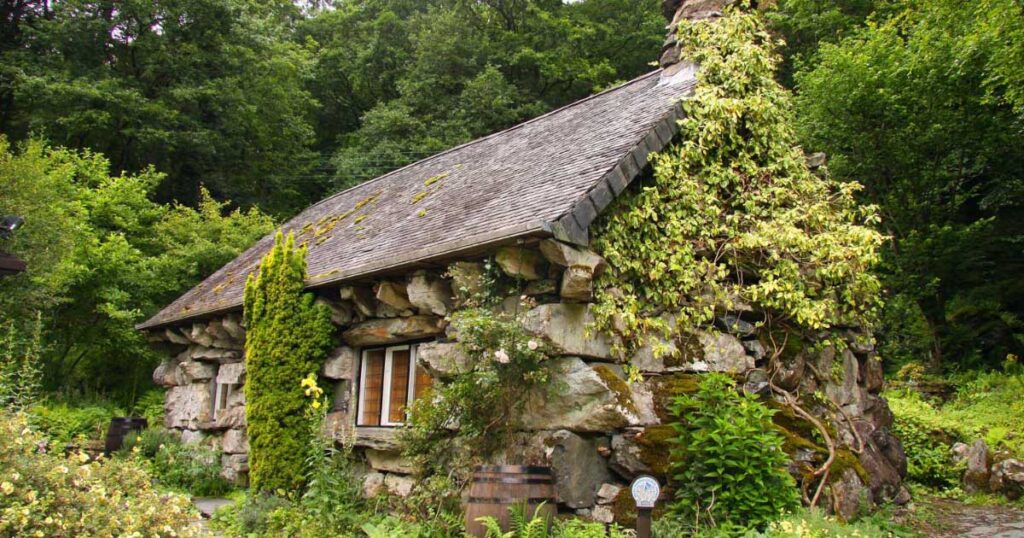
The story of the one night house, or tŷ unnos, is something heard from a friend or relative. The Welsh custom is a quaint tradition with interesting roots. Oral history is keeping the concept alive, although it’s now more legend than reality.
What exactly is a one night house? It’s a dwelling built by squatters in one night. Work would start at dusk, and come daybreak, the home would be standing in what had previously been a vacant spot. There are parallels in the folklore of other countries that might explain where it came from and how it worked.
A Story Passed On Through the Generations
Folklore is any custom preserved among the people by retellings or reenactments, and the one night house certainly fits that description. There’s very little written or recorded about tai unnos , the plural of tŷ unnos. However, thanks to stories told by parents and grandparents to the next generation, some information about the custom survives.
The last one night houses were thought to have been built by squatters more than 100 years ago. The evidence that remains about the Welsh tradition suggests that it was first practiced in the 17th century and went on for the next two hundred years.
During that period, many of the small holdings on larger estates were thought to have come from that tradition. As well as inheriting the tŷ unnos, families took on the tradition. The task was handed down to the next generation, who would go out as the light faded to build their own one night house.
Since the building of one night houses no longer occurs, the idea is fading. Lovers of folklore and history are hoping to keep the tale alive. For the memory of the custom to survive among its people, it needs to be researched, discussed, and told as part of stories.

Poor folk in Wales and elsewhere have squatted on land to claim it for centuries. In Welsh folklore, if you could build a one night house without being detecting – it was yours! ( Public Domain )
A British Tradition
Although the custom is mostly talked about as a Welsh one, there are other tales of one night houses from the land bordering Wales and from other parts of the British Isles . It was a time of population expansion in those parts, and many families were in need of a dwelling.
There were more conventional routes to take to have a home, although many families shared, with the older and younger generations all under one roof. It’s thought that poverty was a driving factor for someone to build a one night house.
Many landowners had fenced off their property for other purposes, and taxation also played a role. It’s no coincidence that the Hearth Tax was levied in 1662 and was later followed by the Land Tax, which acted as a general tax.
Land ownership was a touchy subject throughout the 17th, 18th, and 19th centuries. Much of the land used by commoners was enclosed by the gentry and aristocracy during this time. Based on the evidence in Scottish records , it’s thought that only 3% of the population owned land in the 18th century.
Community Effort
Just because one night houses come from legend doesn’t mean they didn’t get built. As you can imagine, building a house in the dark and in a limited amount of time was no easy thing. The squatters didn’t work alone; they would often gather their friends and relatives to help them work through the night to get the modest dwelling built.
The stories usually start with the squatter and their community gathering materials. They would bring them to the site at dusk, ready to start work as soon as the sun dipped below the horizon. According to tradition, the work would go on all night until the house was finally built.
At daybreak, a fire should be lit in the hearth, so that smoke could be seen coming from the chimney as dawn arrived. Only a build that followed these customs was thought of as a one night house.
Unwritten Rules
It’s not clear why the house had to be built during the night, although, as squatters, the process had to be a secret one. The housebuilder didn’t technically have any rights to the land, after all. It was a generally accepted custom that to complete the work in that short space of time and have the fire burning gave the squatter their rights.
It could also be assumed that if no one noticed the house popping up overnight, then the new homeowner could pretend it had been there all along. Planning law and planning permission didn’t arrive in Britain until the 20th century.
Building a house in one night didn’t grant the squatter permission to live on the land, however; there’s no record of the practice being permitted in Welsh law, or English common law , as it was under at the time. Little is known about whether the squatters succeeded for long and if there were any legal consequences.
Architectural Style
Since there aren’t any authentic examples of a one night house remaining, it’s not possible to know what they looked like. However, there are a few clues to paint a rough picture. In the tales, there wasn’t a specific design to work to, and it’s not known how many people would live in a one night house, but many believe that they weren’t large buildings.
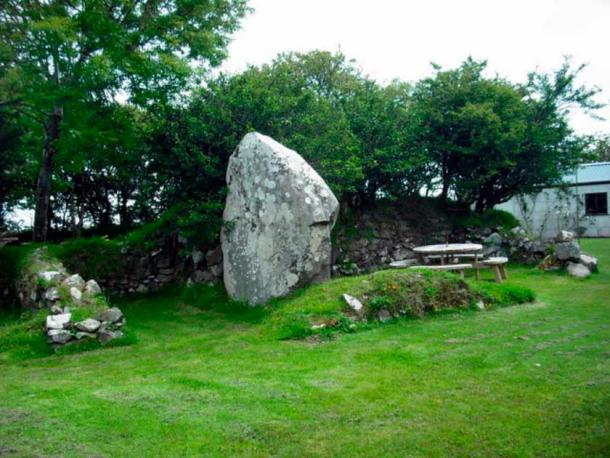
Remains of a ty-unnos or one night house at Maen Dewi The standing stone has been used as the central support to the overnight house that was thrown up by squatters several centuries ago, with the byre on the left and the domestic dwelling room on the right where the garden furniture is. (Bob Helms / CC BY SA 2.0 )
More often than not, they were one-story and one-room dwellings. The site for the build was usually wasteland or a small plot out of the way. Some stories also include the custom that the land around the house was included in the squatters’ rights. Legend has it that the amount of land was measured by seeing how far the squatter could throw an ax from the threshold.
The rules stated that four walls, a fireplace, a roof, and a door was necessary, with additional features, like windows, being added later where possible. Building materials weren’t cheap, but they weren’t scarce either.
Many one night houses are thought to have been built with found materials, usually stone and wood, from the area. Since it involved the work of several people with stones and logs of different sizes, it’s said that the finished article often had an irregular and unusual appearance.
In fact, it was the lack of uniformity in architectural style and the strange appearance of these houses that made them recognizable to others. Thanks to the customs and stories, parents would point out tŷ unnos to their children, and so the tradition lived on.

A simple home in Cardiff resembling a one night house of years past ( Public Domain )
Folklore Revival of One Night Houses
In 2017, a Welsh designer at the Arts Council of Wales teamed up with the community around the National Botanic Garden to build a one night house. The project was commissioned by Common Ground for the Woodland Trust.
His aim was to keep the stories and knowledge of tŷ unnos alive. The project was also designed to connect art with the community and link it all to the local environment and folklore. He didn’t claim his squatter’s rights, though, and the space is used by the community.
The act captured the element of the one night house that’s most relatable. It’s thought to have come from traditions of dares and wagers, where people did something in one night just to prove that they could.
There are a few of reproductions of tai unnos that can be seen today. St. Fagans National Museum of History near Cardiff has Llainfadyn Cottage, which was built in 1962 based on a 1762 example in Gwynedd. Alternatively, a visit to Snowdonia will reveal the Ugly House (Tŷ Hyll), a quaint 19th-century cottage inspired by the tradition.

Llainfadyn Cottage, St Fagans Museum, Cardiff, a reproduction of a one night house (David Hallum Jones / CC BY SA 2.0 )
Inspiring Tales
Besides reproductions and recent one night house projects, folklore has inspired other creative endeavors. There are records suggesting that the last known tŷ unnos was built in 1882 in Flintshire. There’s a fictionalized written account of the adventure in the novel Mushroom Town by Oliver Onions, written in 1914. In the book, the practice is referred to as hafod unos , meaning a summer dwelling of one night.
As with the community project, it’s clear that the attraction lies in the connections and feelings a one night house brings. Folklore is more than just nostalgia; it’s the people’s interactions with their surroundings, especially if they were night owls!
Top image: Tŷ Hyll ( The Ugly House) near Betws-Y-Coed, inspired by the one night house tradition Source: Steve Daniels / CC BY SA 2.0
By Lex Leigh
4 Out Of 10 Americans Delaying Medical Care Over Costs
“Life is Peachy”: The Superb Brightful Girly Characters by Igor Lomov

According to an artist: “Hi, I am Igor and my nickname is Blik_47. I am a certified art teacher, used to work as a graphic designer for many years but my true calling is to create digital art. I post things on social media (always as Blik_47) in both Russian (my native language) and English.
I create original artwork and I never pass other people’s work off as my own. However, I occasionally engage in social media promotion events and repost the work of my followers (with full credit).
I am just about to finish the development of my own cyberpunk board game. It is in a sleek transportable box. The card design, game mechanics, packaging and instructions are all developed only by me. This game has cards and tokens. It can be played by 2-4 players at once. There are two main game modes – “deadly match” and “survival” (cooperative mode against the boss). Both Russian and English versions of the game will available.”











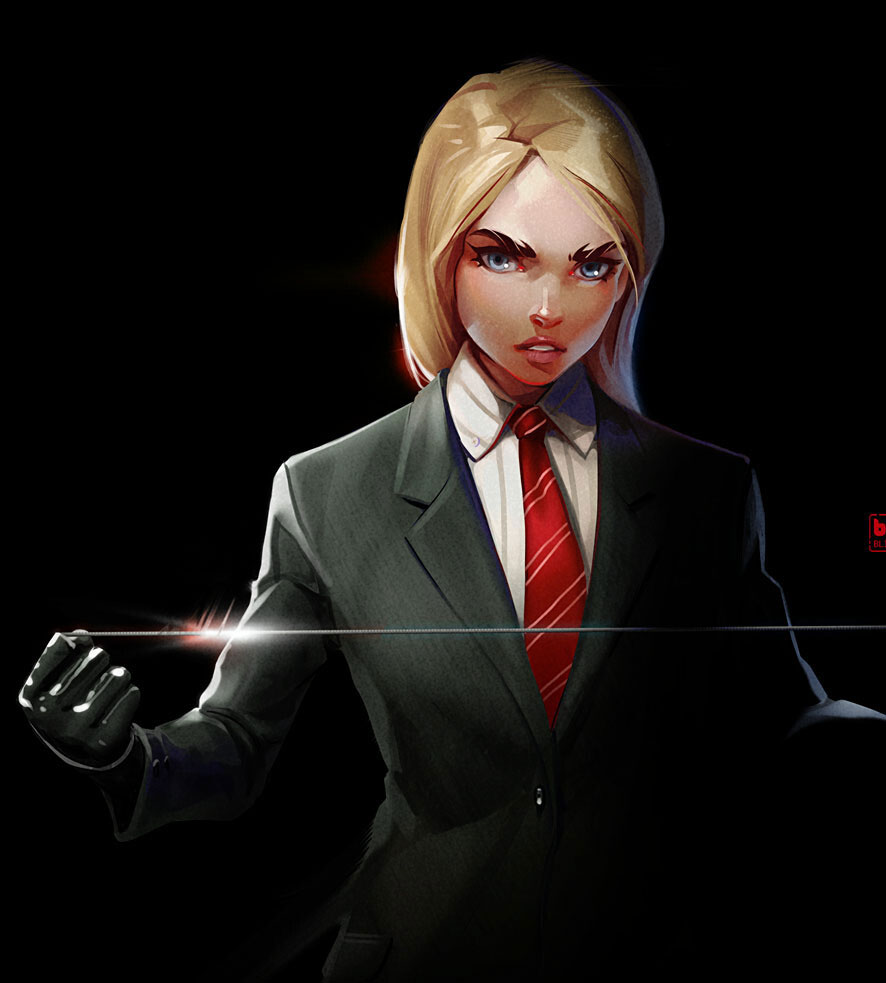











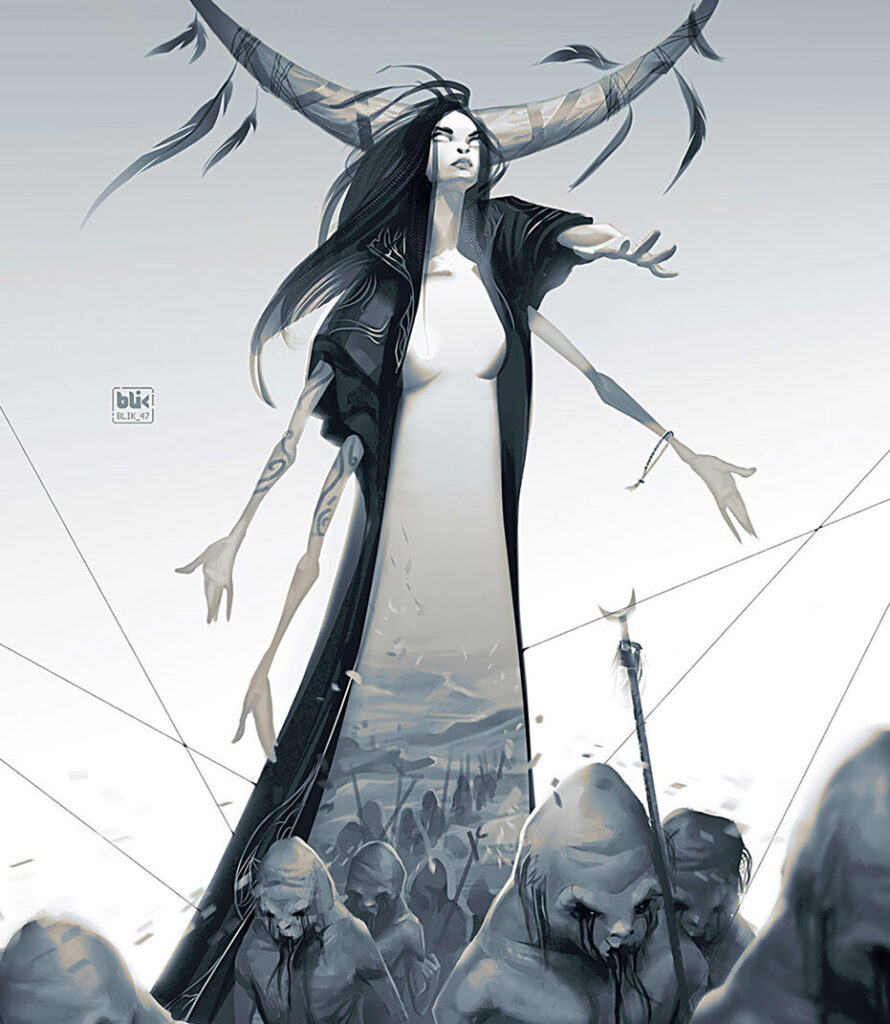







Bacon Cheeseburger Soup

Ingredients
- 8 slices thick-cut bacon, cut crosswise into 1/4 inch strips
- 8 ounces ground beef
- 2 red onions, cut into 1/4 inch dice
- 3 tablespoons Real California unsalted butter
- 4 cloves garlic, minced
- 3 tablespoons all-purpose flour
- 1 teaspoon salt, or more to taste
- 1 teaspoon pepper, or more to taste
- 3 cups beef broth
- 1 1/2 cups Real California Half-and-Half (can use evaporated milk)
- 3 cups shredded Real California sharp Cheddar cheese, divided
- 1 teaspoon yellow mustard
- 1/2 teaspoon Worcestershire sauce
- 1 small tomato, cut into 1/4 inch dice
Instructions
- In a large saucepan or small stockpot over medium heat, cook bacon, stirring occasionally, until crisp, 7 to 9 minutes. Use a slotted spoon to transfer to a paper towel-lined plate.
- Add beef to the saucepan and cook, stirring occasionally and breaking it up, until no longer pink, about 2 minutes. Use a slotted spoon to transfer to a plate.
- Set aside about 1/3 cup of onions. Add remaining onions and butter to the saucepan and cook, stirring occasionally, until tender, 7 to 9 minutes.
- Add garlic and cook, stirring, until fragrant, about 30 seconds. Sprinkle in flour, salt, and pepper and cook, stirring, for 1 minute.
- Add broth and Half-and-Half or milk and bring to a boil. Reduce to a simmer and cook, stirring occasionally, for 5 minutes.
- Add mustard, Worcestershire and 2 1/2 cups of cheese, stirring to melt cheese. Stir in about 3/4 of the bacon and 3/4 of the beef. Add more salt and pepper to taste.
- Serve soup garnished with remaining cheese, remaining bacon, remaining beef, reserved onions and tomatoes.
Prep: 30 min | Cook: 35 min | Yield: 4 to 6 servings
Man Shocked by What He Saw His Pets Doing in Heaven
Great. Just Great! Look at what our $$ millions for each tank gets us . . . .

You want to see first hand how we’ve been getting bilked by the military-industrial complex? Our Abrams tanks . . . you know, our main battle tanks . . . can’t go up hills in the snow. They skid and slide backwards.

This is what Six to nine MILLION DOLLARS EACH buys us?
With weapons systems like this, would be even be able to defend our own country . . . in the winter????
https://htrs-special.s3.us-west-2.amazonaws.com/Abrams-Tanks-Skid-In-Snow.mp4
Creamy Chicken and Wild Rice Soup
Fall is officially here. Now is a great time to try out some hearty autumn dishes like chicken and wild rice soup. Our recipe is rich and creamy. You can serve it as an appetizer if you want, but it’s filling enough to stand on its own as an entrée. This recipe stands out from the rest because it calls for freshly roasted chicken, plenty of delicious vegetables, and a nice dollop of plain Greek Yogurt. Adding yogurt, instead of cream, for example, helps to make this soup extremely flavorful but also relatively light, calorie-wise.

Ingredients
- 1 deli-roasted chicken, about 2 1/2 pounds
- 6 cups water
- 2 medium carrots, ends trimmed and cut into chunks
- 1 small rib celery, cut into chunks
- 1/2 teaspoon whole black peppercorns
- 1 small bay leaf
- 1 tablespoon butter
- 1/2 cup chopped yellow onion
- 1/3 cup uncooked wild rice*
- 1/2 cup heavy cream
- 1/2 cup Cabot 2% Plain Greek Yogurt or Cabot Plain Greek Yogurt
- 2 tablespoons cornstarch
- 2 teaspoons chopped fresh thyme leaves
- 1/4 teaspoon salt, or more to taste
- 1/4 teaspoon ground black pepper, or more to taste
* You can reduce the cooking time with “quick-cooking” wild rice, which is done in about 15 minutes, or substitute another flavorful rice, such as brown basmati.
Instructions
- Pull off meat from chicken, placing skin, bones and any hot or solidified juices in large saucepan. Dice 2 cups of chicken meat, saving rest for another use, and set aside in refrigerator.
- Add water, carrots, celery, peppercorns and bay leaf to saucepan; bring to boil over high heat, then reduce heat to maintain simmer. Cover pan and cook broth for one hour.
- Pour broth through strainer set over large bowl, pressing on solids to extract all broth. Discard solids.
- Melt butter in empty saucepan. Add onions and cook, stirring, for about 3 minutes or until onion is tender and just beginning to brown.
- Pour in strained broth. Add wild rice, bring to simmer and cook covered for 40 to 50 minutes or until rice is tender.
- In small bowl, whisk together heavy cream, yogurt and cornstarch until completely smooth with no small lumps; stir mixture into pot and continue stirring until soup thickens and returns to simmer. Add thyme, salt, pepper and 2 cups of reserved diced chicken.
- Taste soup, adding additional salt and pepper if needed. Stir until heated through and serve.
Yield: about 6 cups for 4 servings
The UNEXPLAINABLE REINCARNATION of Chuck McMurray
“I Will Never Forget The Look On Her Face”: Woman Swaps Sugar For Salt In her Drink To Catch The Office Thief
As the workday drags on, the minutes going slower than a snail up a tree and the clicking of the keys on the keyboards turning into a semi-soothing white noise, you can’t help but think back to that amazing sammich waiting for you at lunchtime. But a pang of fear strikes your heart ever so silently—what if someone steals it?
Workplace thieves are not as rare as they should be, their long fingers tingling with the craving of ruining someone’s day to fuel their selfish desires. Therefore, it’s always satisfying when these people get their just taste of karma, and in this case, it’s extra salty. A woman decided to share her story on r/PettyRevenge, and I think you may know where this is going.
Don’t forget to leave your thoughts in the comments below, sharing any similar stories you may have. And if you’re craving more after this one, Bored Panda has got another article for you right here. It’s a juicy one as well—pun intended. Now let’s get into it!
There’s nothing more frustrating than leaving your food and drinks in the work fridge only to find them all gone when lunchtime comes around



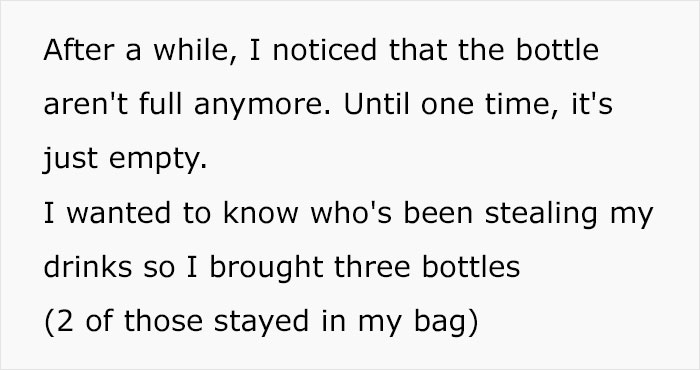


The taste of karma is a delight for those watching justice unfold, but for the troublemaker—it’s nauseating at the very least. A very clear lesson from this story—don’t take things that aren’t yours to take! But why are these stories so commonplace? Are we predisposed to stealing?
As noted in the Diagnostic and Statistical Manual of Mental Disorders, “kleptomania is exceedingly rare, whereas shoplifting is relatively common.” Kleptomania occurs in approximately 0.3–0.6% of the general population, yet there’s something about the work environment that just triggers a surge of wanting to own your coworker’s things.
According to Art Markman, human behavior is focused on doing things that feel right in the short term rather than things that feel right in the long term. The consequences of one’s actions feel more distant compared to the urge to eat or have a tasty drink. Art believes that to decrease small thefts in the workplace, we need to start by making it harder for people to do the wrong thing, but that may be easier said than done.
The key to this puzzle may lie in the motives for stealing in the first place. Brianna Morton shared the insights she gathered from those who’ve been workplace thieves themselves. Some of the reasons for their nefarious actions included seeking revenge on another thieving individual, desperation, and wanting to be a nuisance on purpose.
It’s sad to say, but stealing can become an addiction. According to WebMD, when your brain’s opioid system is unbalanced, you develop strong urges to steal, accompanied by anxiety, arousal, and tension. After stealing, you get a sense of pleasure and relief. Sometimes, you may feel guilt or remorse after the act, but you’re still unable to control the urge.
However, no pleasure should come at the expense of another person, and being stolen from is rarely on anyone’s bucket list. So, all those who are stealing for any other reason than the absolute need for their longevity and survival can get a bunch of salt running down their throat.
We hope that the original poster got their just deserts and they were never stolen from again. And that the lady doing the stealing learned a very valuable lesson.
4 Strange KIDS WHO REMEMBER THEIR PAST LIVES
ANTIFA Attacking Atlanta – Riots, Looting, Fires
Anti-Fascist Action (ANTIFA) is engaging in riots, looting and arson attacks in the city of Atlanta Saturday night. Numerous stores have been looted, several vehicles, including police cars, have been set ablaze.
Mayor Andre Dickens “Many of these protesters are not from Atlanta, and many are not even from the state of Georgia. The Mayor stunned assembled media outlets when he revealed, during a Press conference, some of those arrested “have been found to have explosives on them.”
As most readers readily know, Protesters don’t destroy property and hurl explosives at police, those would be Rioters
The Mayor clearly stated “These people mean harm to people and to property.”
Atlanta is on fire tonight, but @cnn reporters @DavidPeisner & @PamelaBrownCNN are reporting Atlanta police officers, NOT protestors, are committing violence for tackling & arresting these thugs burning and destroying a police cruiser and store front windows.
This is a developing story. More as I get it.
UPDATE 10:19 PM EST —
and:
Violent Antifa protectors are calling for a ‘Night of Rage’ against police officers after a raid of ‘Cop City’ left an activist dead and a state trooper injured.
Georgia State Patrol troopers swooped on the autonomous zone at the site of the future $90million Atlanta Public Safety Training Center in a ‘clearing operation’ on Wednesday.
In a press conference, Georgia Bureau of Investigations director Michael Register confirmed that the shooting was in self-defense, with the protestor opening fire ‘without warning’ at the trooper.
But activists are now calling for a ‘Night of Rage’ and bloodshed against the police following the shooting – threatening to enact ‘reciprocal violence’ against the authorities.
Japanese Artist Paints Hyperrealistic Paintings That Are So Precise You Might Confuse Them With Photos

This time, I want to present an incredible gallery of pictures of… paintings. Although it might be hard to believe these were actually painted by a human hand, this is a true representation of the beauty and power of talent and hard work.
Japanese painter Kei Mieno creates painstakingly detailed and realistic paintings that can be easily mistaken for photographs. Let’s admit, the kinds of photographs not everyone would be able to take. Colors, lights, shadows, contrasts, texture—everything comes together to create incredibly lifelike artwork. The remarkably skillful artist, who celebrates his 36th birthday today, uses oil to bring his hyperrealistic ideas to life.













Scientist Clinically Dead For 6 Minutes; Leaves Earth And Is Shown The Afterlife (NDE)
Beef Stroganoff Soup

Yield: 6 servings
Ingredients
- 1 pound beef sirloin steak, trimmed and cut into bite-size pieces
- Salt and pepper
- 1 1/2 tablespoons butter
- 1 1/2 tablespoons olive oil
- 8 ounces fresh button mushrooms, sliced
- 1 cup chopped onion
- 2 cloves garlic, minced
- 4 1/2 cups beef broth (low-sodium or regular)
- 1/2 cup red wine
- 1 tablespoon Worcestershire sauce
- 1 tablespoon tomato paste
- 1 1/2 cups dried egg noodles
- 1/2 cup sour cream
- 2 tablespoons all-purpose flour
- Snipped fresh parsley (optional)
Instructions
- Sprinkle steak with salt and pepper.
- In a Dutch oven, melt butter with olive oil over medium-high heat. Cook steak one-half at a time, in until browned. Set beef aside.
- Add mushrooms, onion and garlic to Dutch oven. Cook and stir over medium heat for 5 to 7 minutes or until mushrooms are tender.
- Stir in beef, broth, wine, Worcestershire sauce, tomato paste; bring to boiling. Cover, and reduce to a simmer; cook for 45 minutes until beef is tender.
- Add noodles; boil gently, uncovered, for 6 to 7 minutes until noodles are tender.
- In a medium bowl, whisk together sour cream and flour. Add to soup, and cook, stirring until bubbly.
During 3 Week Coma; Woman Is Shown The Reason We Come Here (NDE)
Remember who you are.
This event sounds more like she was tapping into the collective consciousness via prayers rather than a full-on NDE.

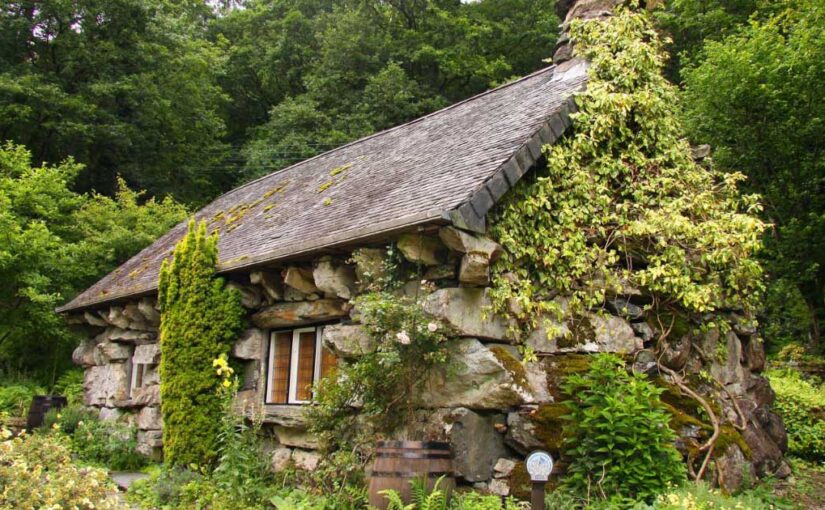

Cheers MM for todays post.
Hey, Zero Two, Alyx, Alice, Catwoman Sarah Connor.
I recognize a lot of these pictures Igor.
And yes, the Alt Left is leveraging another case of police brutality to cause extensive amounts of damage to property and police, and yet Vault 7 defaults to calling it a peaceful protest, just like how the George Floyd Riots had entire buildings on fire and stores looted yet the news spoke of these as activism and peaceful protesting.